The Accidentally Perfect Campiness of the ‘Star Wars’ Prequels
Queen Amidala (Natalie Portman) in “Star Wars: Episode I — The Phantom Menace.” (Courtesy Lucasfilm)
April 11, 2021
For movies that get consistently scathing reviews from fans and critics alike, you’d think the “Star Wars” prequels would have been forgotten by now.
“The Phantom Menace” is ranked on Rotten Tomatoes as 10th out of the 12 “Star Wars” films, followed by “Attack of the Clones” at number nine and “Revenge of the Sith” at a lackluster number seven. After the infamously brutal reception of the prequels, director George Lucas left the public filmmaking industry — and it upended some of the actors’ careers. Jake Lloyd, who was just 10 years old when “The Phantom Menace” was released, faced constant harassment from fans and critics who were unhappy with his performance as young Anakin Skywalker. The emotional toll forced Lloyd to quit acting and it compounded with serious mental health struggles in his adult life.
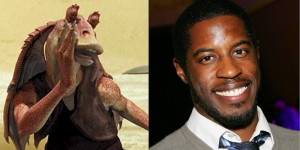
Ahmed Best recently opened up about his struggle with contemplating suicide after portraying Jar Jar Binks in Episodes I, II and III. The character of Jar Jar Binks is hated for dozens of reasons, but chief among them is the charge that Jar Jar Binks is a harmful caricature of African stereotypes. For over two decades, Best — who is Black and of West Indian descent — has faced severe backlash from both conservatives and progressives for his role in the film. “There was just so much hate and anger and venom directed at me… I was called every racial stereotype you can imagine,” Best said.
But hateable as they may be, the prequels are also unkillable. They’re immortalized in our cultural memory via memes, social media and popular parodies. They’re driving a significant chunk of new Disney+ content, including an upcoming series that will bring back Ewan McGregor as Obi-Wan Kenobi and Hayden Christensen as Darth Vader.
The prequels are anything but forgotten. In one of my Zoom meetings the other day, we were all asked to introduce ourselves with our pronouns and favorite movie. As soon as someone mentioned “Revenge of the Sith,” the meeting erupted in clapping-hands emojis and messages of agreement in the chat. I pictured myself as a child at the theater with my dad, experiencing the insane culmination of a trilogy I loved.
Whether you watched Anakin Skywalker become Darth Vader back in 2005 or not, the name “Star Wars” invokes something visceral in most of us. People worship these movies, loathe them, or look down on them, but no matter what — they’re here to stay. Why?
Jar Jar Binks, Supervillain of the Prequels

First, we have to look at what went wrong. Jar Jar Binks is arguably the final boss of the prequel saga, but not because of the fan theory that the clumsy Naboo native is literally a Sith Lord. The fact that a racially charged CGI amphibian from 1999 is making national headlines decades later — because he’s maybe an evil mastermind in disguise — should tell you a lot about the culture surrounding the prequels.
Jar Jar Binks is the actual supervillain of the prequel trilogy in that his character perfectly embodies the critiques of the three films themselves: he talks constantly but doesn’t add much to the overarching story; he’s goofy enough to be infuriating, but not quirky enough to be lovable; the racist undertones in his writing — like the writing of the “greedy” Nute Gunray, an alien with slanted eyes and an exaggerated Asian accent — are hard to ignore; and he’s the product of a turn-of-the-century animation team that got a bit carried away with their CGI budget. These are the sins that have sentenced the prequels to cinema purgatory.
The thing is, I agree with many takes like these and, simultaneously, I can’t be convinced that a better trilogy exists. Endure their Jar-Jar-Binks-ness if you can, and a dazzling world emerges.
The Prequels as Unintentional Camp
For those of us who grew up with the prequels, they are fundamental stories of our childhood and adolescence. The movies inspired lightsaber duels between me and my siblings and weekends consumed by “Star Wars: Battlefront II” on Xbox. Even now, the characters, planets and possibilities of the prequels, still feel like they transcend the movies themselves. I feel like Edna Mode when I talk about the prequels — they’re “bold, dramatic, heroic.” And they might also be campy.
The postmodern art genre of “camp” is loosely defined as a “deliberately exaggerated and theatrical behavior or style.” It’s “so bad it’s good.” Rooted in queer resistance art like drag, camp is ironically self-referential or even self-satirical, over-the-top and subversive.
Could campiness be the reason the “Star Wars” prequels keep living to see another day? Do they thrive not in spite of their many flaws, but rather because of them? Let’s take a look.
First off, the entire “Star Wars” universe references itself constantly, but Lucas has been very clear that the movies aren’t meant to be the self-satire many viewers take them for. Regardless of Lucas’s serious intentions, the end result is stories that exist in playful meta relation to one another. This cinematic self-awareness — fans call it “full-circle storytelling” and critics call it “fan service” — is visible in a continued reliance on the original 1977 lore and a never-ending revival of past characters. Plus, the fourth wall of “Star Wars” is constantly being broken by introductory text crawls, curtain wipes between scenes and C3PO’s asides to the audience. The movies are designed to feel like live in-person productions.
The prequels take that atmosphere to the extreme — which leads us to the fact that there’s no questioning their theatricality. Zany, drapey costumes and makeup paired with cartoonish sci-fi technology make for quite the campy production.
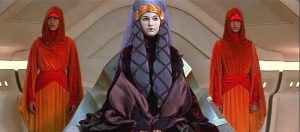
Audiences of “The Phantom Menace,” for example, weren’t quite sure where to even begin unpacking its onslaught of CGI and green-screen. In 1999, one critic said, “The movie could be described with little exaggeration as an elaborate, state-of-the-art cartoon featuring live-action” with “three times as many computer-generated shots as any film in history.” The director himself was shocked when he watched Episode I. “It boggles the mind… It’s a little disjointed. It’s bold in terms of jerking people around. I may have gone too far in a few places,” Lucas said immediately after his first screening.
Or, we can take a look at Ian McDiarmid’s Chancellor Palpatine in “Revenge of the Sith.” Cloaked in velvet robes, feminine choreography and over-the-top but unforgettable one-liners, he’s the essence of camp.
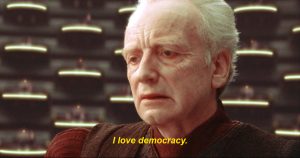
Lastly, we have camp’s resistance against gender, class and other cultural norms. As theatrical and self-aware as the prequels are, their huge budgets, heteronormativity and subtexts of colonization are anything but subversive. If we peel back the glittery sci-fi trappings and look at the actual narrative underneath “Star Wars,” there’s nothing radical or revolutionary. All of Lucas’s stories are familiar and predictable — he drew directly from Greek and Hindu mythology, Japanese samurai films and United States imperialism.
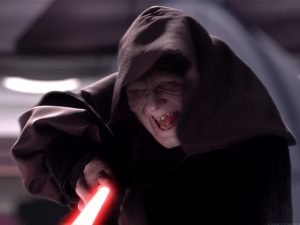
But the prequels take these tried-and-true stories and slap them together into a risky mosaic of a saga. “Camp turns its back on the good-bad axis of ordinary aesthetic judgment,” said Susan Sontag in her seminal 1964 work, “Notes on Camp.”
Albeit unintentionally, the prequels reject modern measures of “good” cinema. They spare no expense as they drown us in their extravagant music, special effects and set design — there is always so much happening at once. Their stories diverge from the black-and-white hero’s journey of the acclaimed originals and instead tell the story of shattering relationships and civilizations. The movies dare audiences to care about the consequences of seemingly mundane political affairs. Through flashy lightsaber fights and convoluted trade agreements, the prequels wanted to say something subversive after all — “Democracies aren’t overthrown; they’re given away,” Lucas said, noting that he had anti-Iraq war sentiments in mind when writing the prequels.
Ironic or Not, They’re Iconic
“Without passion, one gets pseudo-Camp — what is merely decorative, safe, in a word, chic,” Sontag said. Hate them if you will, but you can’t argue that the prequels are void of passion.
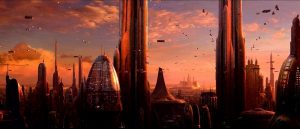
Yes, Padmé staring over the Coruscant skyline to the tune of melodramatic moaning is a scene straight out of a soap opera — and every time I watch it, I still get chills. Even as I physically shudder at teenage Anakin’s disturbing romance dialogue that feels like it couldn’t have possibly been written by actual humans in this universe, I know I’ll be watching the movie again at some point soon. And even when I get whiplash from the prequels’ cuts between dozens of different CGI characters, each with their own backstory on a different planet, I love the ride. Each scene builds and connects into an epically over-the-top play that spans decades.
It’s entirely possible that “love has blinded me” and the prequels aren’t real camp at all. Maybe this article is just one fanboy’s attempt to reclaim a beloved trilogy from collective hatred, but I don’t mind. I know the “Star Wars” prequels weren’t ironically intended to be as cringey as they are, and this is what makes them far more interesting than Lucas’s originals or Disney’s prequels. They’re fantastic. While some of their flaws are harmful, most of them are timelessly and unforgettably iconic.













Claudia Trent • Dec 10, 2021 at 3:48 am
This article is a joke and rather pathetic to me.